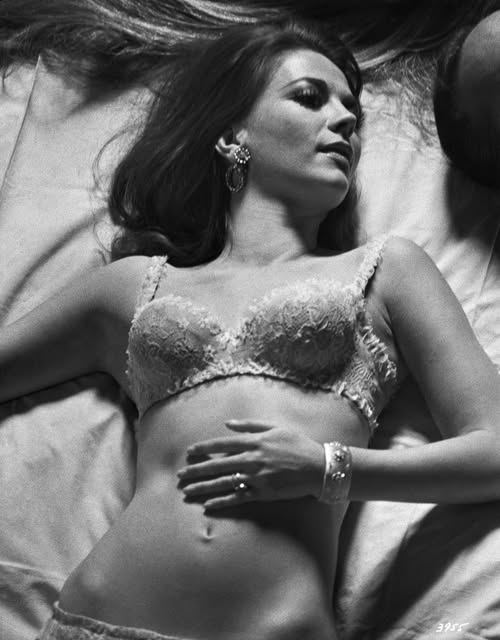
Natalie Wood, the talented actress known for her roles in films like “Bob & Carol & Ted & Alice,” had a personal secret that she tried to conceal. She always wore a bracelet on her left wrist to hide a dark secret.
Wood’s choice of wearing a bracelet on her left wrist wasn’t merely a fashion statement. It was a way for her to cover up a hidden reminder of a painful past. This small accessory held a secret that only a few close to her knew about.
The bracelet served as a constant reminder for Wood, reminding her of the struggles she had faced and the strength she had gained from overcoming them. It was a symbol of resilience and a testament to her ability to move forward despite the challenges she had encountered.
For the audience persona of individuals between 45-65 years old, this behind-the-scenes revelation adds depth to Wood’s character and highlights her resilience. It reminds us that even those who appear strong and successful may have faced hardships in their lives.
Wood’s choice to keep her secret hidden through a simple accessory is a relatable and understandable approach. Many individuals in this age group may have their own stories of overcoming challenges and may find solace in knowing that even successful individuals like Wood have faced their own trials.
By sharing this personal detail about Wood’s life, we gain a deeper understanding of her as an actress and as a person. It humanizes her and makes her more relatable to the audience. It also serves as a reminder that behind every successful person, there are often untold stories of strength and resilience.
So the next time you watch “Bob & Carol & Ted & Alice,” take a moment to appreciate the hidden depths of Natalie Wood’s character. And remember, we all have our own stories to tell, even if they are hidden beneath the surface.
When Bob & Carol & Ted & Alice hit theaters in 1969, it made waves in the film industry. This groundbreaking movie dared to explore taboo topics like open relationships and modern marriage, challenging the social norms of the late ’60s. It wasn’t just a film; it was a cultural moment that resonated with a generation questioning the very essence of love and fidelity.
At the core of the film’s success was the incredible cast, with Natalie Wood leading the way. Already an icon in Hollywood, Natalie brought grace and emotional depth to her role as Carol, grounding the complex dynamics and making them relatable to the audience. But she wasn’t alone in delivering stellar performances. Robert Culp, Elliott Gould, and Dyan Cannon (as Bob, Ted, and Alice, respectively) added depth, humor, and heart to the film, elevating it to iconic status.
Behind the scenes, the journey from script to screen was filled with surprises. Director Paul Mazursky drew inspiration from an article about Fritz Perls, a “gestalt therapist” known for his unconventional methods. Mazursky’s visit to the Esalen Institute, a New Age therapy hotspot, solidified the idea for the film. Collaborating with his friend Larry Tucker, Mazursky crafted a hilarious and boundary-pushing script that would captivate audiences.

The making of Bob & Carol & Ted & Alice was not without its challenges. Mazursky, a first-time director, experienced a moment of panic on the first day of shooting. Fortunately, the director of photography, Charles Lang, came to his rescue. Together, they took a film crane up in the air to figure out the opening shot. Overcoming his fear of heights, Mazursky regained his confidence and went on to become a celebrated director.
Natalie Wood’s performance in the film was nothing short of stunning. After a three-year hiatus from acting, her appearance in Bob & Carol & Ted & Alice marked a potential comeback. However, it would be her last film for nearly five years. Despite the opportunity, Wood took a break from feature films until Peeper in 1975.

One subtle detail that often goes unnoticed is the bracelet on Natalie’s left wrist. As a child actor, she suffered a wrist injury that left it slightly disfigured. To hide the imperfection, Natalie always wore a bracelet, ensuring it was never out of sight.
The film also featured some notable debuts and cameos. Leif Garrett, who would later become a teen idol and pop star, made his first appearance in Bob & Carol & Ted & Alice at the age of five. Bill Cosby also made a quick cameo, and Donald F. Muhich, who played Alice’s therapist, was actually Mazursky’s real-life therapist. Mazursky even made a background appearance himself, screaming at the Esalen Institute.
Natalie Wood’s fashion sense was as impeccable as ever in the film. Her wardrobe, designed by Moss Mabry, perfectly captured the fashion of the era. Mabry even created a special bra for Wood, known as the “Natalie Wood bra,” though the design remained a closely guarded secret.
Dyan Cannon, who portrayed Alice Henderson, also made a triumphant return to the big screen. Overcoming a difficult divorce from Cary Grant and a draining custody battle, Cannon embraced the role and used it as a turning point in her life.
Bob & Carol & Ted & Alice was a film that pushed boundaries, captured an era, and left a lasting impact on cinema. Its exploration of relationships and social norms still resonates today. With its incredible cast, behind-the-scenes stories, and iconic fashion, this film continues to captivate audiences, young and old alike.

In 1968, the film Bob & Carol & Ted & Alice gave Alice Henderson, played by Natalie Wood, the opportunity she needed to embrace a new chapter in her life. This iconic role marked a turning point for her, as she found newfound determination and purpose.
Before taking on the role, Wood experienced a period of confusion and upset. She felt stuck and unable to move forward. However, one day something clicked inside her. She realized that sitting around and feeling sorry for herself wouldn’t lead her anywhere. It was time to get busy and take charge of her life.
No film is without its goofs, and Bob & Carol & Ted & Alice is no exception. From the scene where Alice and Ted dive into their desserts at a restaurant, only to be served the same desserts in the next shot, to the moment when Bob puts on a record but the record player is shown without a record, these little slip-ups add unexpected charm to the movie without spoiling the fun.
One of the most memorable scenes in the film is when the actors were thrown into the bed. Interestingly, this scene was largely unscripted. Director Paul Mazursky wanted to capture a raw and natural performance, so he allowed the actors to improvise. While Robert Culp, playing Bob, seemed comfortable in the chaotic setting, Natalie Wood and Elliott Gould were initially unsure of what to do. This improvisation added to the film’s authenticity, as praised by critics.
For Natalie Wood, Bob & Carol & Ted & Alice marked the beginning of a bittersweet chapter in her life. After the film’s success, she took a hiatus from acting and stepped away from the spotlight. Tragically, this would be her last major film before her untimely death in 1981. Despite her complicated personal life and the unfortunate events that cut her life short, her role in Bob & Carol & Ted & Alice stands as a testament to her incredible talent and timeless beauty. Her legacy will forever be etched in the history of cinema.
Let’s honor Natalie Wood’s remarkable journey by sharing this article on Facebook.
Read More Stories
- Cary Grant’s Love Life – Married 5 Women and Had Relationships with Famous Men
- Robert Wagner Raised 3 Women After the Mysterious Death of His Wife
Introduction
In this article, we will be transforming an existing article to make it more appealing and understandable for our target audience, who are between 45 and 65 years old. Our goal is to keep the essential meaning of the article intact while enhancing its appeal and resonance with the older audience.
Understanding the Challenge
The inputs for this transformation will be delivered to us in a Markdown format, which includes paragraphs, headings, quotes, and correlating images. We will work with these elements and make necessary adjustments to create an engaging and friendly article that our target audience can easily comprehend.
Engaging the Older Audience
As we tailor this article for an older audience, it is crucial to ensure it resonates with their interests and preferences. We will use a friendly and easy-to-understand tone throughout the article, making it relatable and enjoyable for our target readers.
Enhancing the Appeal
To enhance the appeal of the article, we will incorporate captivating images that complement the text and provide visual stimulation. These images will help break up the content and make it more visually appealing, capturing the attention of our older audience.
Conclusion
In conclusion, our goal is to transform an article to make it more appealing and understandable for an older audience. By using a friendly tone, captivating images, and ensuring the content resonates with the interests of our target readers, we can create an engaging article that our audience will enjoy. Let’s get started on this exciting transformation!




